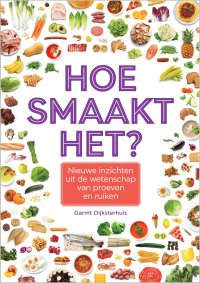Ilustration: Paul Gerlach
In his lectures and classes, taste and smell researcher Garmt Dijksterhuis often talks about what happens in the human body when we eat, which senses play a role, and how the brain gets involved. ‘I often give the same examples and the audience responds with enthusiasm.’ So in the winter of 2012, Dijksterhuis forged a plan to write them all down. And now he has published the book he has been writing in his spare time, with long gaps: Hoe smaakt het? (How does it taste?).

Taste and smell researcher Garmt Dijksterhuis
The main point the researcher makes in the book is that there is more to tasting than the sense of taste. Actually, we taste with all our senses, he says. That is why chefs present their thin slices of home-smoked fillet of duck breast on a bed of rocket garnished with carrot rosettes and a colourful mango chutney. The eye wants a treat too. Dijksterhuis says this is why eating in the dark does not work. ‘The theory behind it is that you taste more because you are more focused on taste and smell. That is not my experience. If you consider that all the senses play a role, it is not too surprising that you actually taste less if one of the senses is out of action.’
Snap, crackel and taste
Not only do we look at our food: we listen to it too. Not so much to butterscotch or oyster mushrooms perhaps, but certainly to crisps. A study at the University of Oxford showed that people’s assessment of the freshness of crisps depends on the sound they make in the mouth.
Background noise affects our taste experience too. In a noisy environment, for instance, food tastes less sweet and less salty, revealed a study by Unilever and the University of Manchester. Dijksterhuis: ‘The press seized on this as an explanation of why aeroplane meals are so tasteless.’
Besides odour, taste, appearance and sound, the feel of food is important too. Some people find fatty rind on meat disgusting, not because of the taste but because of the slimy structure. We feel whether food is warm or cold, hard or soft, tough or crunchy with the tongue, the roof of the mouth and the jaws. Without that ‘mouthfeel’, it is hard to tell what we are eating, explains Dijksterhuis. ‘That is comparable to eating in the dark. Take one sense away and it suddenly gets quite a bit harder. Pureed pumpkin or carrot: it’s all just orange-coloured mush and that makes it all the same.’
A stringent sensation
A familiar, and for many people unpleasant, mouthfeel is the dry, rough, astringent sensation after drinking red wine or eating spinach. The tannin in these products reduces the production of saliva, causing that rough feeling if you run your tongue over your teeth. The opposite of this astringency is a creamy mouthfeel. Almost everyone likes that feeling. The downside is that creamy products tend to be high in calories, so scientists are searching for cream substitutes that are not fattening. Not an easy task. A fat substitute was once produced which could not be converted in the gut and therefore delivered zero calories, says Dijksterhuis. The only disadvantage of the substance was that it was metabolized so fast that it caused a symptom graphically described as anal leakage.

Garmt Dijksterhuis’s book: Hoe smaakt het? Nieuwe inzichten uit de wetenschap van proeven en ruiken
Between the ears
It is not just the senses which determine how we experience flavour. A lot of tasting actually takes place between the ears. Dijksterhuis gives several nice examples in his book. If we have learned, for example, that red foods taste sweeter, that is what we will experience. Water with a tasteless red colouring added to it suddenly tastes sweeter than plain water.
Researcher Andy Woods demonstrated experimentally that there is a change in brain activity when we have particular expectations. He gave people diluted orange juice to drink and got them to lie down in a brain scanner. When the researcher told the test subjects they were going to taste ‘something very sweet’, more activity was seen in the part of the brain that processes taste. The orange juice tasted sweeter, without any extra sugar or sweetener being added.
Bitter
Most of our likes and dislikes are developed in the course of our lives, writes Dijksterhuis. ‘Delicious’, he says, is not so much a matter of taste as of emotion. ‘What we like and dislike is first and foremost related to our history, ideas, upbringing and culture.’ There are exceptions, though. Our aversion to bitterness is something we are born with. In nature, bitterness often signals poison. If we had to learn from bitter experience over and over again, it would cost a lot of lives.
*Painfully delicious
Capsaicin is the substance in hot peppers that sets your mouth on fire. It does so by stimulating the pain nerves. That doesn’t stop some people deliberately seeking out this sweat-inducing, painful culinary experience. That is probably because pain and pleasure are not, as we have long thought, the opposite of each other. Instead, recent research findings suggest that pain and pleasure have a lot in common. When the brain experiences pain, endorphins are released which work as painkillers. The feel-good chemical dopamine, associated with pleasant experiences, is released too. That explains why food that hurts can be enjoyable.

